Thomas Cook: Organizational Theory and Practice Analysis Report
VerifiedAdded on 2023/01/11
|11
|3851
|22
Report
AI Summary
This report provides a comprehensive analysis of Thomas Cook's organizational theory and practice. It delves into the management style employed, highlighting collaborative and transformational approaches, and examines the principles and functions of management utilized. The report assesses the effectiveness of Thomas Cook's hierarchical organizational structure and its impact on employees, including communication and specialization benefits. Furthermore, it explores the leadership styles of the CEO, emphasizing inspirational and democratic approaches, and their role in enhancing organizational effectiveness. The analysis extends to the effects of power, influence, and conflicts within the organization, as well as the various types of motivation implemented. The report also includes corporate examples, suggestions, and recommendations for improving organizational performance, offering a complete overview of Thomas Cook's organizational dynamics.
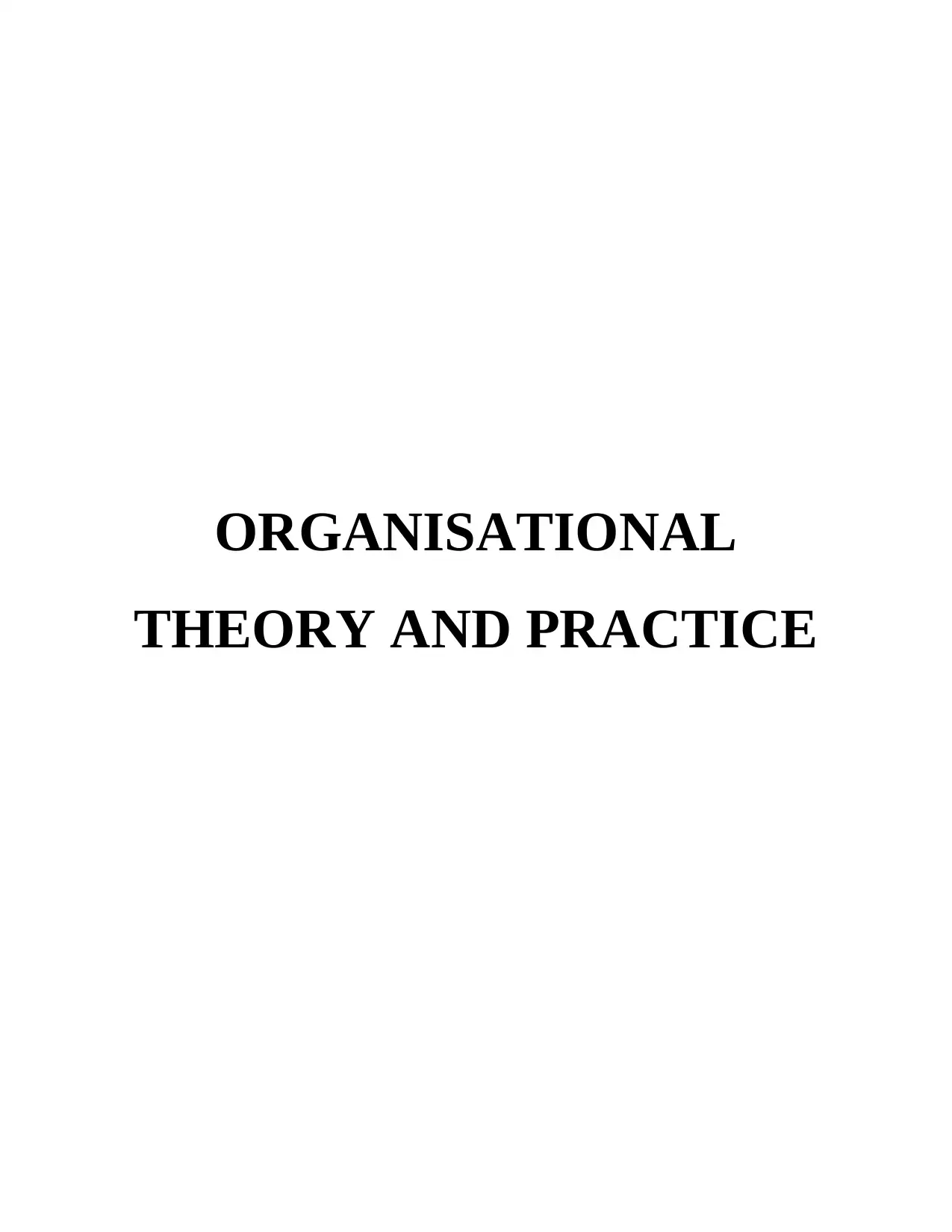
ORGANISATIONAL
THEORY AND PRACTICE
THEORY AND PRACTICE
Paraphrase This Document
Need a fresh take? Get an instant paraphrase of this document with our AI Paraphraser
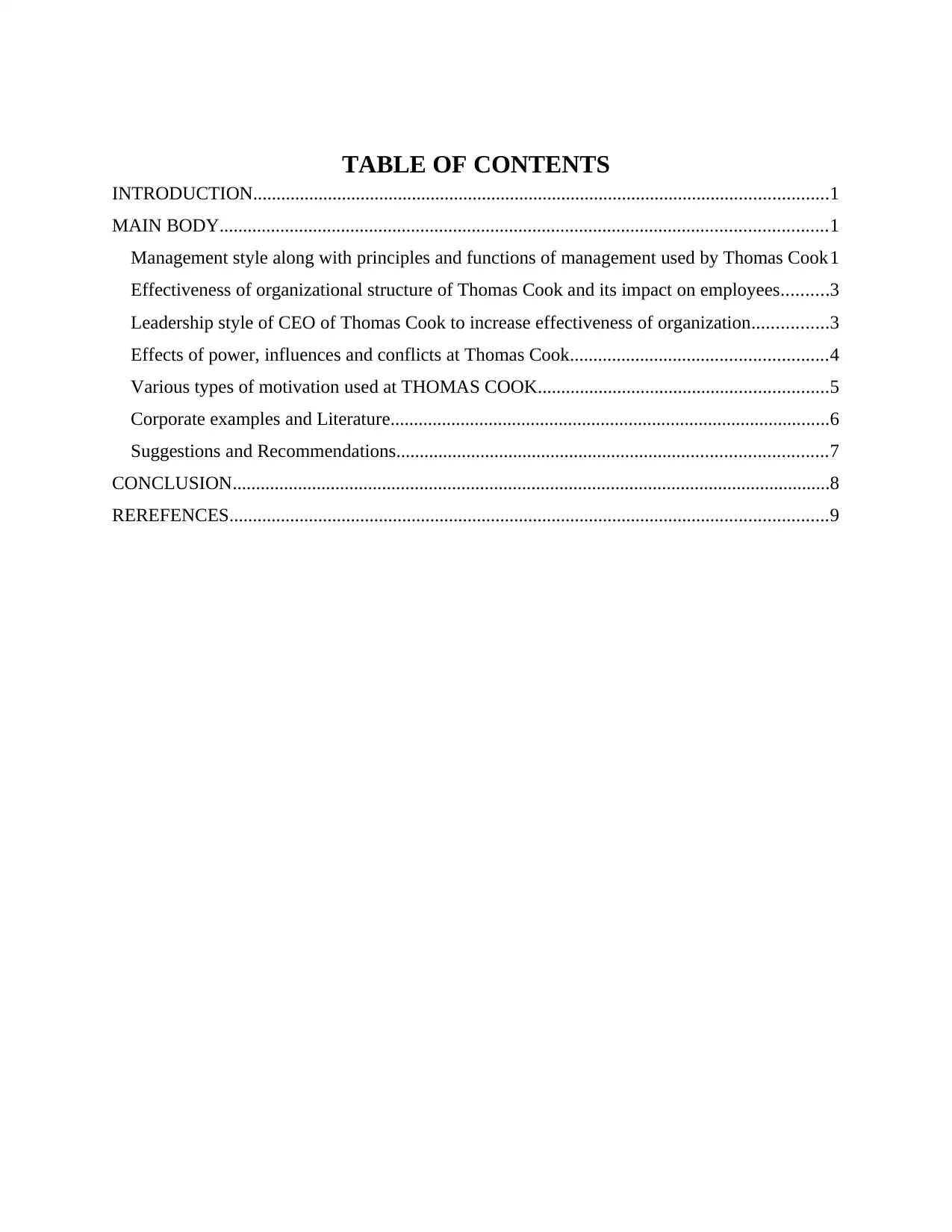
TABLE OF CONTENTS
INTRODUCTION...........................................................................................................................1
MAIN BODY..................................................................................................................................1
Management style along with principles and functions of management used by Thomas Cook1
Effectiveness of organizational structure of Thomas Cook and its impact on employees..........3
Leadership style of CEO of Thomas Cook to increase effectiveness of organization................3
Effects of power, influences and conflicts at Thomas Cook.......................................................4
Various types of motivation used at THOMAS COOK..............................................................5
Corporate examples and Literature..............................................................................................6
Suggestions and Recommendations............................................................................................7
CONCLUSION................................................................................................................................8
REREFENCES................................................................................................................................9
INTRODUCTION...........................................................................................................................1
MAIN BODY..................................................................................................................................1
Management style along with principles and functions of management used by Thomas Cook1
Effectiveness of organizational structure of Thomas Cook and its impact on employees..........3
Leadership style of CEO of Thomas Cook to increase effectiveness of organization................3
Effects of power, influences and conflicts at Thomas Cook.......................................................4
Various types of motivation used at THOMAS COOK..............................................................5
Corporate examples and Literature..............................................................................................6
Suggestions and Recommendations............................................................................................7
CONCLUSION................................................................................................................................8
REREFENCES................................................................................................................................9
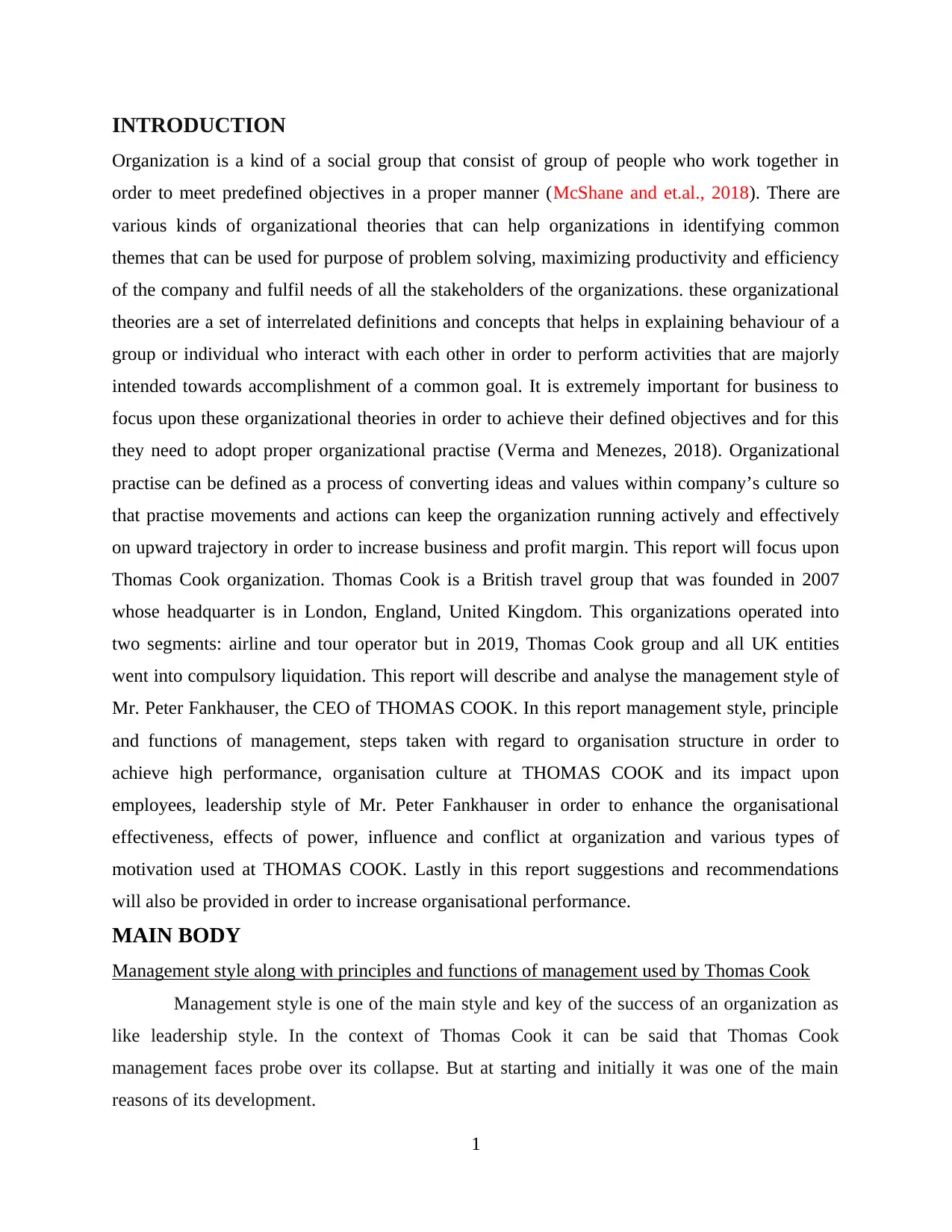
INTRODUCTION
Organization is a kind of a social group that consist of group of people who work together in
order to meet predefined objectives in a proper manner (McShane and et.al., 2018). There are
various kinds of organizational theories that can help organizations in identifying common
themes that can be used for purpose of problem solving, maximizing productivity and efficiency
of the company and fulfil needs of all the stakeholders of the organizations. these organizational
theories are a set of interrelated definitions and concepts that helps in explaining behaviour of a
group or individual who interact with each other in order to perform activities that are majorly
intended towards accomplishment of a common goal. It is extremely important for business to
focus upon these organizational theories in order to achieve their defined objectives and for this
they need to adopt proper organizational practise (Verma and Menezes, 2018). Organizational
practise can be defined as a process of converting ideas and values within company’s culture so
that practise movements and actions can keep the organization running actively and effectively
on upward trajectory in order to increase business and profit margin. This report will focus upon
Thomas Cook organization. Thomas Cook is a British travel group that was founded in 2007
whose headquarter is in London, England, United Kingdom. This organizations operated into
two segments: airline and tour operator but in 2019, Thomas Cook group and all UK entities
went into compulsory liquidation. This report will describe and analyse the management style of
Mr. Peter Fankhauser, the CEO of THOMAS COOK. In this report management style, principle
and functions of management, steps taken with regard to organisation structure in order to
achieve high performance, organisation culture at THOMAS COOK and its impact upon
employees, leadership style of Mr. Peter Fankhauser in order to enhance the organisational
effectiveness, effects of power, influence and conflict at organization and various types of
motivation used at THOMAS COOK. Lastly in this report suggestions and recommendations
will also be provided in order to increase organisational performance.
MAIN BODY
Management style along with principles and functions of management used by Thomas Cook
Management style is one of the main style and key of the success of an organization as
like leadership style. In the context of Thomas Cook it can be said that Thomas Cook
management faces probe over its collapse. But at starting and initially it was one of the main
reasons of its development.
1
Organization is a kind of a social group that consist of group of people who work together in
order to meet predefined objectives in a proper manner (McShane and et.al., 2018). There are
various kinds of organizational theories that can help organizations in identifying common
themes that can be used for purpose of problem solving, maximizing productivity and efficiency
of the company and fulfil needs of all the stakeholders of the organizations. these organizational
theories are a set of interrelated definitions and concepts that helps in explaining behaviour of a
group or individual who interact with each other in order to perform activities that are majorly
intended towards accomplishment of a common goal. It is extremely important for business to
focus upon these organizational theories in order to achieve their defined objectives and for this
they need to adopt proper organizational practise (Verma and Menezes, 2018). Organizational
practise can be defined as a process of converting ideas and values within company’s culture so
that practise movements and actions can keep the organization running actively and effectively
on upward trajectory in order to increase business and profit margin. This report will focus upon
Thomas Cook organization. Thomas Cook is a British travel group that was founded in 2007
whose headquarter is in London, England, United Kingdom. This organizations operated into
two segments: airline and tour operator but in 2019, Thomas Cook group and all UK entities
went into compulsory liquidation. This report will describe and analyse the management style of
Mr. Peter Fankhauser, the CEO of THOMAS COOK. In this report management style, principle
and functions of management, steps taken with regard to organisation structure in order to
achieve high performance, organisation culture at THOMAS COOK and its impact upon
employees, leadership style of Mr. Peter Fankhauser in order to enhance the organisational
effectiveness, effects of power, influence and conflict at organization and various types of
motivation used at THOMAS COOK. Lastly in this report suggestions and recommendations
will also be provided in order to increase organisational performance.
MAIN BODY
Management style along with principles and functions of management used by Thomas Cook
Management style is one of the main style and key of the success of an organization as
like leadership style. In the context of Thomas Cook it can be said that Thomas Cook
management faces probe over its collapse. But at starting and initially it was one of the main
reasons of its development.
1
⊘ This is a preview!⊘
Do you want full access?
Subscribe today to unlock all pages.

Trusted by 1+ million students worldwide
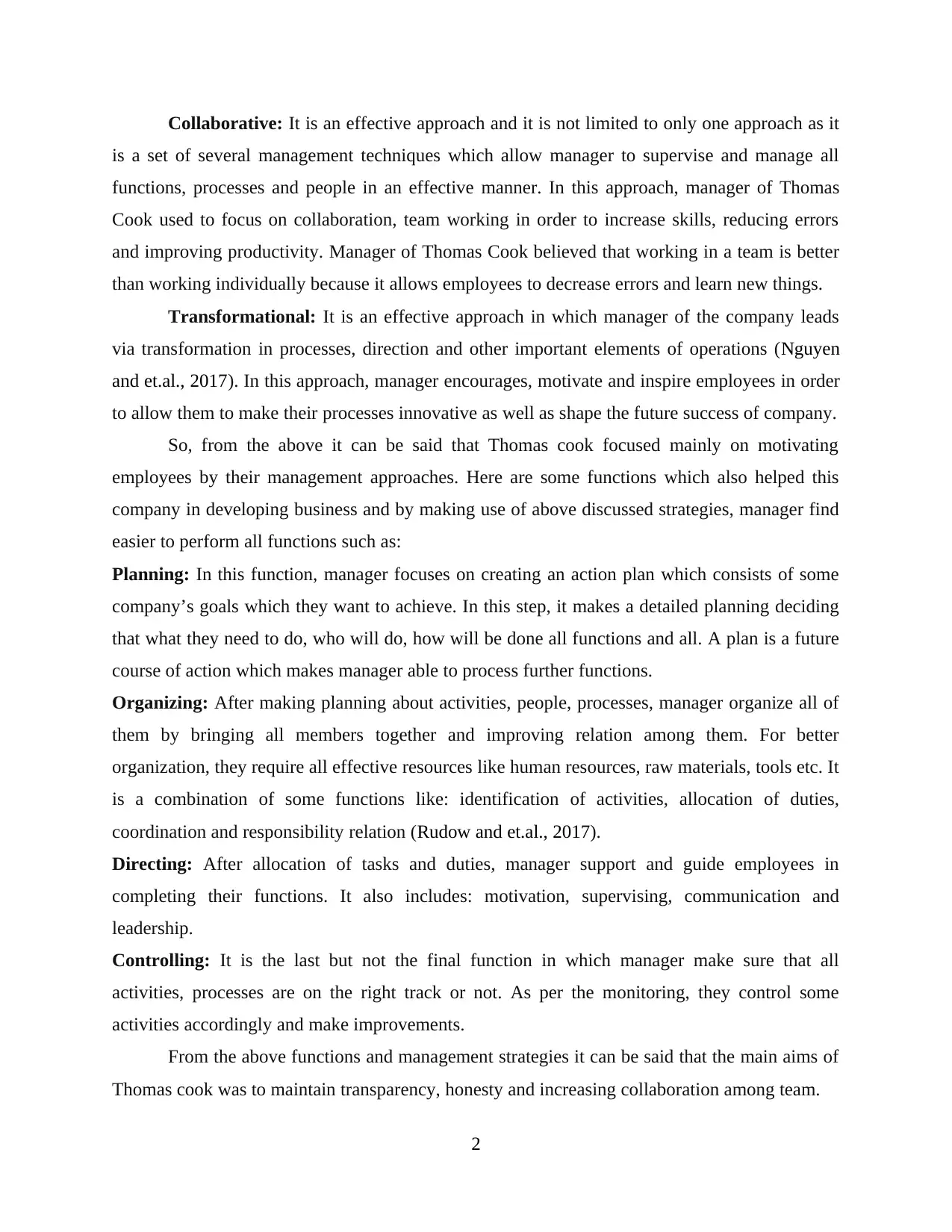
Collaborative: It is an effective approach and it is not limited to only one approach as it
is a set of several management techniques which allow manager to supervise and manage all
functions, processes and people in an effective manner. In this approach, manager of Thomas
Cook used to focus on collaboration, team working in order to increase skills, reducing errors
and improving productivity. Manager of Thomas Cook believed that working in a team is better
than working individually because it allows employees to decrease errors and learn new things.
Transformational: It is an effective approach in which manager of the company leads
via transformation in processes, direction and other important elements of operations (Nguyen
and et.al., 2017). In this approach, manager encourages, motivate and inspire employees in order
to allow them to make their processes innovative as well as shape the future success of company.
So, from the above it can be said that Thomas cook focused mainly on motivating
employees by their management approaches. Here are some functions which also helped this
company in developing business and by making use of above discussed strategies, manager find
easier to perform all functions such as:
Planning: In this function, manager focuses on creating an action plan which consists of some
company’s goals which they want to achieve. In this step, it makes a detailed planning deciding
that what they need to do, who will do, how will be done all functions and all. A plan is a future
course of action which makes manager able to process further functions.
Organizing: After making planning about activities, people, processes, manager organize all of
them by bringing all members together and improving relation among them. For better
organization, they require all effective resources like human resources, raw materials, tools etc. It
is a combination of some functions like: identification of activities, allocation of duties,
coordination and responsibility relation (Rudow and et.al., 2017).
Directing: After allocation of tasks and duties, manager support and guide employees in
completing their functions. It also includes: motivation, supervising, communication and
leadership.
Controlling: It is the last but not the final function in which manager make sure that all
activities, processes are on the right track or not. As per the monitoring, they control some
activities accordingly and make improvements.
From the above functions and management strategies it can be said that the main aims of
Thomas cook was to maintain transparency, honesty and increasing collaboration among team.
2
is a set of several management techniques which allow manager to supervise and manage all
functions, processes and people in an effective manner. In this approach, manager of Thomas
Cook used to focus on collaboration, team working in order to increase skills, reducing errors
and improving productivity. Manager of Thomas Cook believed that working in a team is better
than working individually because it allows employees to decrease errors and learn new things.
Transformational: It is an effective approach in which manager of the company leads
via transformation in processes, direction and other important elements of operations (Nguyen
and et.al., 2017). In this approach, manager encourages, motivate and inspire employees in order
to allow them to make their processes innovative as well as shape the future success of company.
So, from the above it can be said that Thomas cook focused mainly on motivating
employees by their management approaches. Here are some functions which also helped this
company in developing business and by making use of above discussed strategies, manager find
easier to perform all functions such as:
Planning: In this function, manager focuses on creating an action plan which consists of some
company’s goals which they want to achieve. In this step, it makes a detailed planning deciding
that what they need to do, who will do, how will be done all functions and all. A plan is a future
course of action which makes manager able to process further functions.
Organizing: After making planning about activities, people, processes, manager organize all of
them by bringing all members together and improving relation among them. For better
organization, they require all effective resources like human resources, raw materials, tools etc. It
is a combination of some functions like: identification of activities, allocation of duties,
coordination and responsibility relation (Rudow and et.al., 2017).
Directing: After allocation of tasks and duties, manager support and guide employees in
completing their functions. It also includes: motivation, supervising, communication and
leadership.
Controlling: It is the last but not the final function in which manager make sure that all
activities, processes are on the right track or not. As per the monitoring, they control some
activities accordingly and make improvements.
From the above functions and management strategies it can be said that the main aims of
Thomas cook was to maintain transparency, honesty and increasing collaboration among team.
2
Paraphrase This Document
Need a fresh take? Get an instant paraphrase of this document with our AI Paraphraser
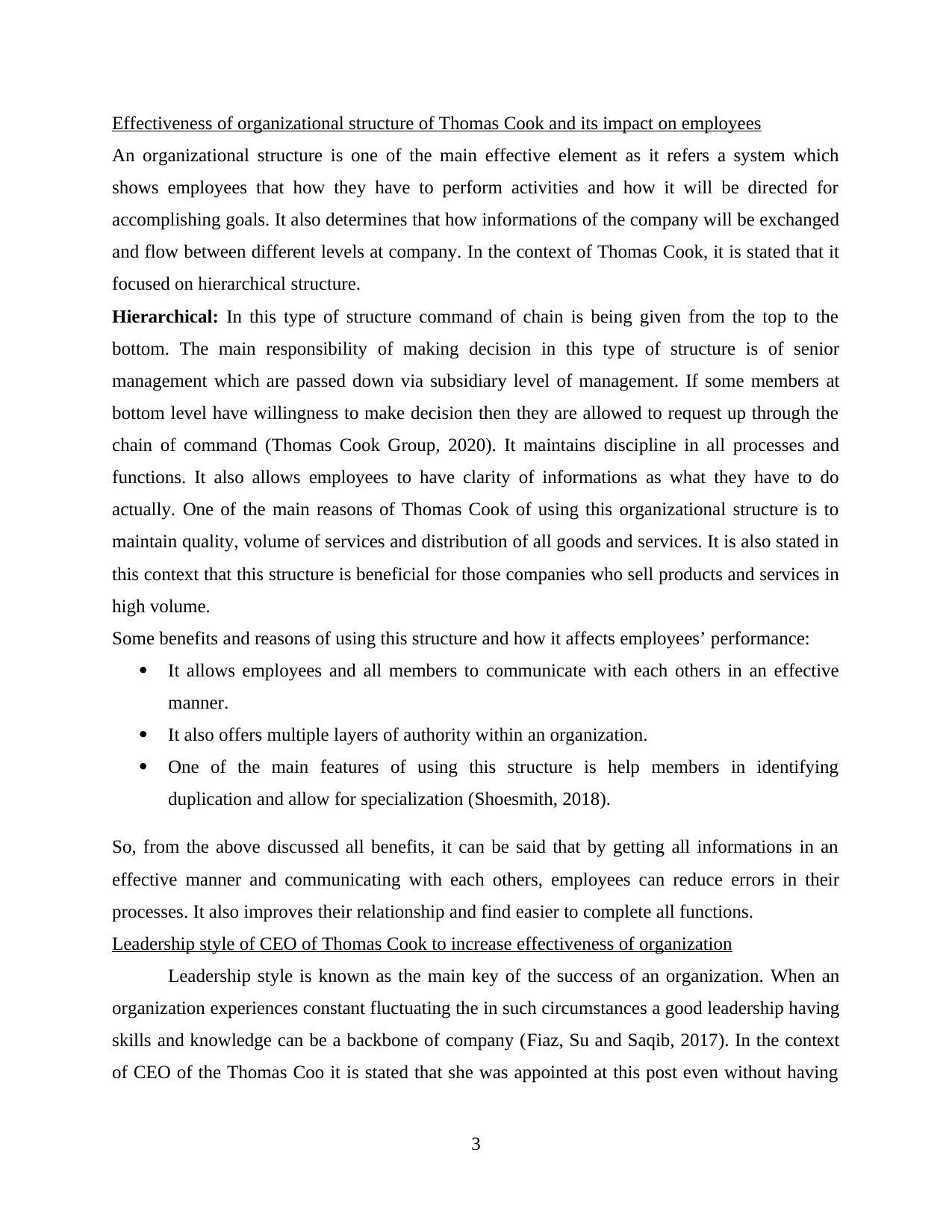
Effectiveness of organizational structure of Thomas Cook and its impact on employees
An organizational structure is one of the main effective element as it refers a system which
shows employees that how they have to perform activities and how it will be directed for
accomplishing goals. It also determines that how informations of the company will be exchanged
and flow between different levels at company. In the context of Thomas Cook, it is stated that it
focused on hierarchical structure.
Hierarchical: In this type of structure command of chain is being given from the top to the
bottom. The main responsibility of making decision in this type of structure is of senior
management which are passed down via subsidiary level of management. If some members at
bottom level have willingness to make decision then they are allowed to request up through the
chain of command (Thomas Cook Group, 2020). It maintains discipline in all processes and
functions. It also allows employees to have clarity of informations as what they have to do
actually. One of the main reasons of Thomas Cook of using this organizational structure is to
maintain quality, volume of services and distribution of all goods and services. It is also stated in
this context that this structure is beneficial for those companies who sell products and services in
high volume.
Some benefits and reasons of using this structure and how it affects employees’ performance:
It allows employees and all members to communicate with each others in an effective
manner.
It also offers multiple layers of authority within an organization.
One of the main features of using this structure is help members in identifying
duplication and allow for specialization (Shoesmith, 2018).
So, from the above discussed all benefits, it can be said that by getting all informations in an
effective manner and communicating with each others, employees can reduce errors in their
processes. It also improves their relationship and find easier to complete all functions.
Leadership style of CEO of Thomas Cook to increase effectiveness of organization
Leadership style is known as the main key of the success of an organization. When an
organization experiences constant fluctuating the in such circumstances a good leadership having
skills and knowledge can be a backbone of company (Fiaz, Su and Saqib, 2017). In the context
of CEO of the Thomas Coo it is stated that she was appointed at this post even without having
3
An organizational structure is one of the main effective element as it refers a system which
shows employees that how they have to perform activities and how it will be directed for
accomplishing goals. It also determines that how informations of the company will be exchanged
and flow between different levels at company. In the context of Thomas Cook, it is stated that it
focused on hierarchical structure.
Hierarchical: In this type of structure command of chain is being given from the top to the
bottom. The main responsibility of making decision in this type of structure is of senior
management which are passed down via subsidiary level of management. If some members at
bottom level have willingness to make decision then they are allowed to request up through the
chain of command (Thomas Cook Group, 2020). It maintains discipline in all processes and
functions. It also allows employees to have clarity of informations as what they have to do
actually. One of the main reasons of Thomas Cook of using this organizational structure is to
maintain quality, volume of services and distribution of all goods and services. It is also stated in
this context that this structure is beneficial for those companies who sell products and services in
high volume.
Some benefits and reasons of using this structure and how it affects employees’ performance:
It allows employees and all members to communicate with each others in an effective
manner.
It also offers multiple layers of authority within an organization.
One of the main features of using this structure is help members in identifying
duplication and allow for specialization (Shoesmith, 2018).
So, from the above discussed all benefits, it can be said that by getting all informations in an
effective manner and communicating with each others, employees can reduce errors in their
processes. It also improves their relationship and find easier to complete all functions.
Leadership style of CEO of Thomas Cook to increase effectiveness of organization
Leadership style is known as the main key of the success of an organization. When an
organization experiences constant fluctuating the in such circumstances a good leadership having
skills and knowledge can be a backbone of company (Fiaz, Su and Saqib, 2017). In the context
of CEO of the Thomas Coo it is stated that she was appointed at this post even without having
3
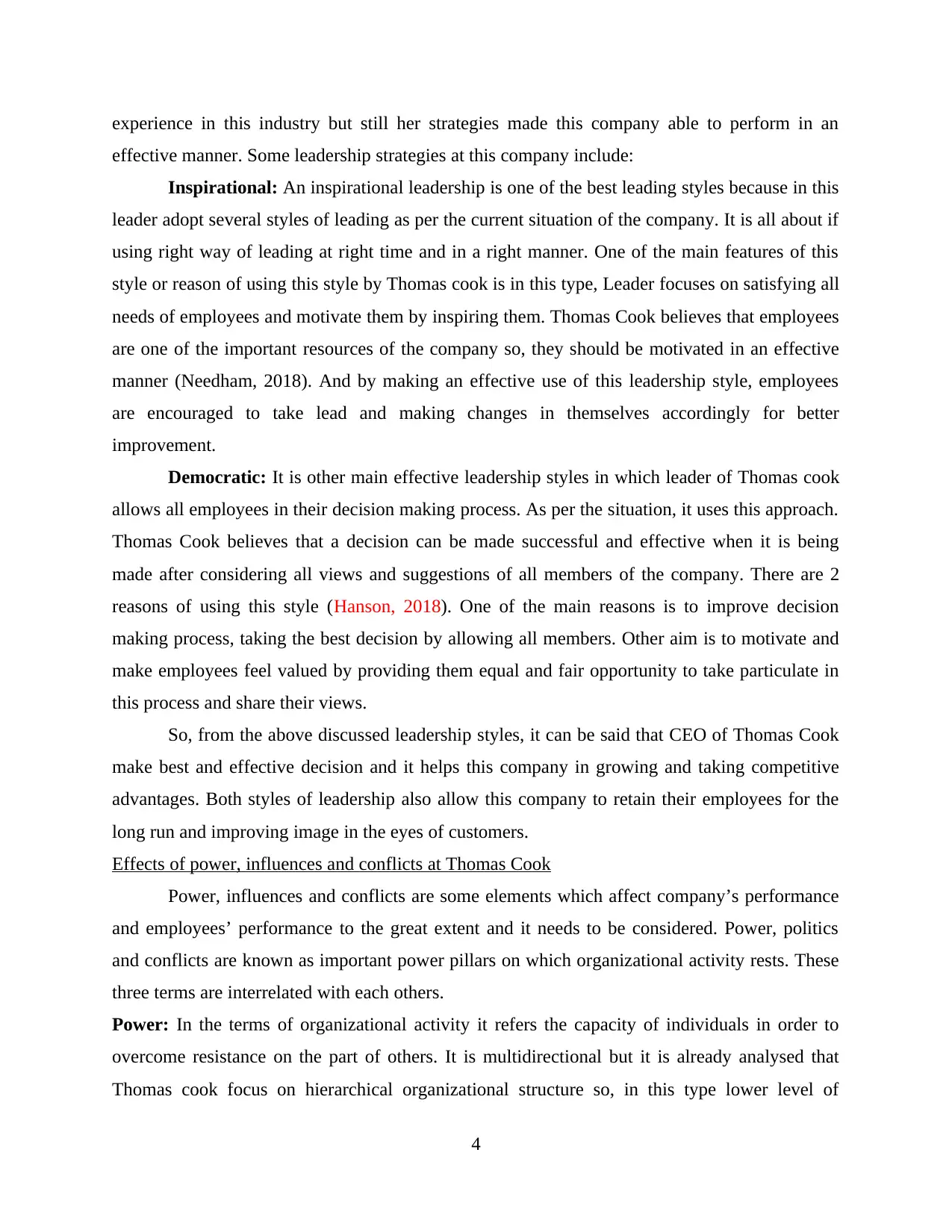
experience in this industry but still her strategies made this company able to perform in an
effective manner. Some leadership strategies at this company include:
Inspirational: An inspirational leadership is one of the best leading styles because in this
leader adopt several styles of leading as per the current situation of the company. It is all about if
using right way of leading at right time and in a right manner. One of the main features of this
style or reason of using this style by Thomas cook is in this type, Leader focuses on satisfying all
needs of employees and motivate them by inspiring them. Thomas Cook believes that employees
are one of the important resources of the company so, they should be motivated in an effective
manner (Needham, 2018). And by making an effective use of this leadership style, employees
are encouraged to take lead and making changes in themselves accordingly for better
improvement.
Democratic: It is other main effective leadership styles in which leader of Thomas cook
allows all employees in their decision making process. As per the situation, it uses this approach.
Thomas Cook believes that a decision can be made successful and effective when it is being
made after considering all views and suggestions of all members of the company. There are 2
reasons of using this style (Hanson, 2018). One of the main reasons is to improve decision
making process, taking the best decision by allowing all members. Other aim is to motivate and
make employees feel valued by providing them equal and fair opportunity to take particulate in
this process and share their views.
So, from the above discussed leadership styles, it can be said that CEO of Thomas Cook
make best and effective decision and it helps this company in growing and taking competitive
advantages. Both styles of leadership also allow this company to retain their employees for the
long run and improving image in the eyes of customers.
Effects of power, influences and conflicts at Thomas Cook
Power, influences and conflicts are some elements which affect company’s performance
and employees’ performance to the great extent and it needs to be considered. Power, politics
and conflicts are known as important power pillars on which organizational activity rests. These
three terms are interrelated with each others.
Power: In the terms of organizational activity it refers the capacity of individuals in order to
overcome resistance on the part of others. It is multidirectional but it is already analysed that
Thomas cook focus on hierarchical organizational structure so, in this type lower level of
4
effective manner. Some leadership strategies at this company include:
Inspirational: An inspirational leadership is one of the best leading styles because in this
leader adopt several styles of leading as per the current situation of the company. It is all about if
using right way of leading at right time and in a right manner. One of the main features of this
style or reason of using this style by Thomas cook is in this type, Leader focuses on satisfying all
needs of employees and motivate them by inspiring them. Thomas Cook believes that employees
are one of the important resources of the company so, they should be motivated in an effective
manner (Needham, 2018). And by making an effective use of this leadership style, employees
are encouraged to take lead and making changes in themselves accordingly for better
improvement.
Democratic: It is other main effective leadership styles in which leader of Thomas cook
allows all employees in their decision making process. As per the situation, it uses this approach.
Thomas Cook believes that a decision can be made successful and effective when it is being
made after considering all views and suggestions of all members of the company. There are 2
reasons of using this style (Hanson, 2018). One of the main reasons is to improve decision
making process, taking the best decision by allowing all members. Other aim is to motivate and
make employees feel valued by providing them equal and fair opportunity to take particulate in
this process and share their views.
So, from the above discussed leadership styles, it can be said that CEO of Thomas Cook
make best and effective decision and it helps this company in growing and taking competitive
advantages. Both styles of leadership also allow this company to retain their employees for the
long run and improving image in the eyes of customers.
Effects of power, influences and conflicts at Thomas Cook
Power, influences and conflicts are some elements which affect company’s performance
and employees’ performance to the great extent and it needs to be considered. Power, politics
and conflicts are known as important power pillars on which organizational activity rests. These
three terms are interrelated with each others.
Power: In the terms of organizational activity it refers the capacity of individuals in order to
overcome resistance on the part of others. It is multidirectional but it is already analysed that
Thomas cook focus on hierarchical organizational structure so, in this type lower level of
4
⊘ This is a preview!⊘
Do you want full access?
Subscribe today to unlock all pages.

Trusted by 1+ million students worldwide
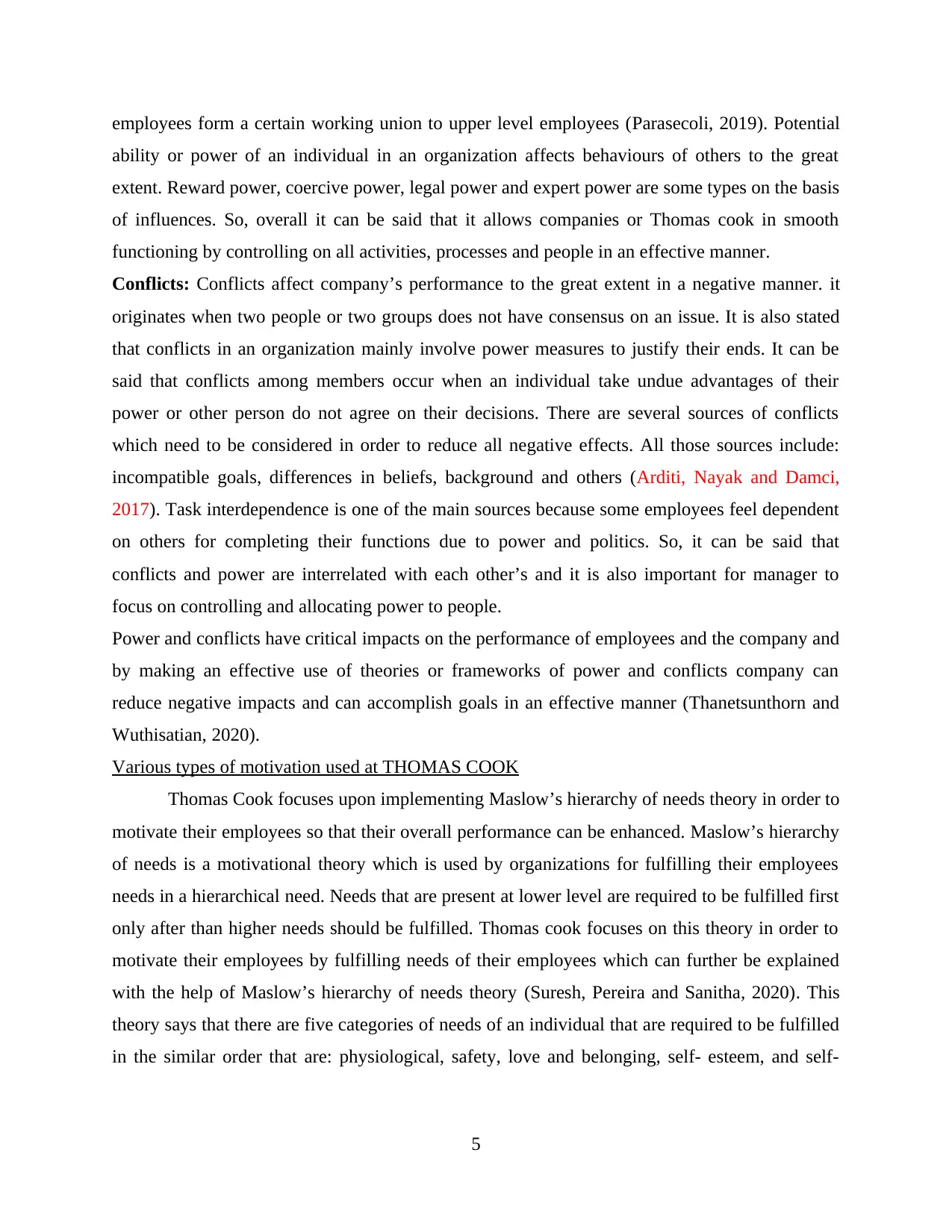
employees form a certain working union to upper level employees (Parasecoli, 2019). Potential
ability or power of an individual in an organization affects behaviours of others to the great
extent. Reward power, coercive power, legal power and expert power are some types on the basis
of influences. So, overall it can be said that it allows companies or Thomas cook in smooth
functioning by controlling on all activities, processes and people in an effective manner.
Conflicts: Conflicts affect company’s performance to the great extent in a negative manner. it
originates when two people or two groups does not have consensus on an issue. It is also stated
that conflicts in an organization mainly involve power measures to justify their ends. It can be
said that conflicts among members occur when an individual take undue advantages of their
power or other person do not agree on their decisions. There are several sources of conflicts
which need to be considered in order to reduce all negative effects. All those sources include:
incompatible goals, differences in beliefs, background and others (Arditi, Nayak and Damci,
2017). Task interdependence is one of the main sources because some employees feel dependent
on others for completing their functions due to power and politics. So, it can be said that
conflicts and power are interrelated with each other’s and it is also important for manager to
focus on controlling and allocating power to people.
Power and conflicts have critical impacts on the performance of employees and the company and
by making an effective use of theories or frameworks of power and conflicts company can
reduce negative impacts and can accomplish goals in an effective manner (Thanetsunthorn and
Wuthisatian, 2020).
Various types of motivation used at THOMAS COOK
Thomas Cook focuses upon implementing Maslow’s hierarchy of needs theory in order to
motivate their employees so that their overall performance can be enhanced. Maslow’s hierarchy
of needs is a motivational theory which is used by organizations for fulfilling their employees
needs in a hierarchical need. Needs that are present at lower level are required to be fulfilled first
only after than higher needs should be fulfilled. Thomas cook focuses on this theory in order to
motivate their employees by fulfilling needs of their employees which can further be explained
with the help of Maslow’s hierarchy of needs theory (Suresh, Pereira and Sanitha, 2020). This
theory says that there are five categories of needs of an individual that are required to be fulfilled
in the similar order that are: physiological, safety, love and belonging, self- esteem, and self-
5
ability or power of an individual in an organization affects behaviours of others to the great
extent. Reward power, coercive power, legal power and expert power are some types on the basis
of influences. So, overall it can be said that it allows companies or Thomas cook in smooth
functioning by controlling on all activities, processes and people in an effective manner.
Conflicts: Conflicts affect company’s performance to the great extent in a negative manner. it
originates when two people or two groups does not have consensus on an issue. It is also stated
that conflicts in an organization mainly involve power measures to justify their ends. It can be
said that conflicts among members occur when an individual take undue advantages of their
power or other person do not agree on their decisions. There are several sources of conflicts
which need to be considered in order to reduce all negative effects. All those sources include:
incompatible goals, differences in beliefs, background and others (Arditi, Nayak and Damci,
2017). Task interdependence is one of the main sources because some employees feel dependent
on others for completing their functions due to power and politics. So, it can be said that
conflicts and power are interrelated with each other’s and it is also important for manager to
focus on controlling and allocating power to people.
Power and conflicts have critical impacts on the performance of employees and the company and
by making an effective use of theories or frameworks of power and conflicts company can
reduce negative impacts and can accomplish goals in an effective manner (Thanetsunthorn and
Wuthisatian, 2020).
Various types of motivation used at THOMAS COOK
Thomas Cook focuses upon implementing Maslow’s hierarchy of needs theory in order to
motivate their employees so that their overall performance can be enhanced. Maslow’s hierarchy
of needs is a motivational theory which is used by organizations for fulfilling their employees
needs in a hierarchical need. Needs that are present at lower level are required to be fulfilled first
only after than higher needs should be fulfilled. Thomas cook focuses on this theory in order to
motivate their employees by fulfilling needs of their employees which can further be explained
with the help of Maslow’s hierarchy of needs theory (Suresh, Pereira and Sanitha, 2020). This
theory says that there are five categories of needs of an individual that are required to be fulfilled
in the similar order that are: physiological, safety, love and belonging, self- esteem, and self-
5
Paraphrase This Document
Need a fresh take? Get an instant paraphrase of this document with our AI Paraphraser
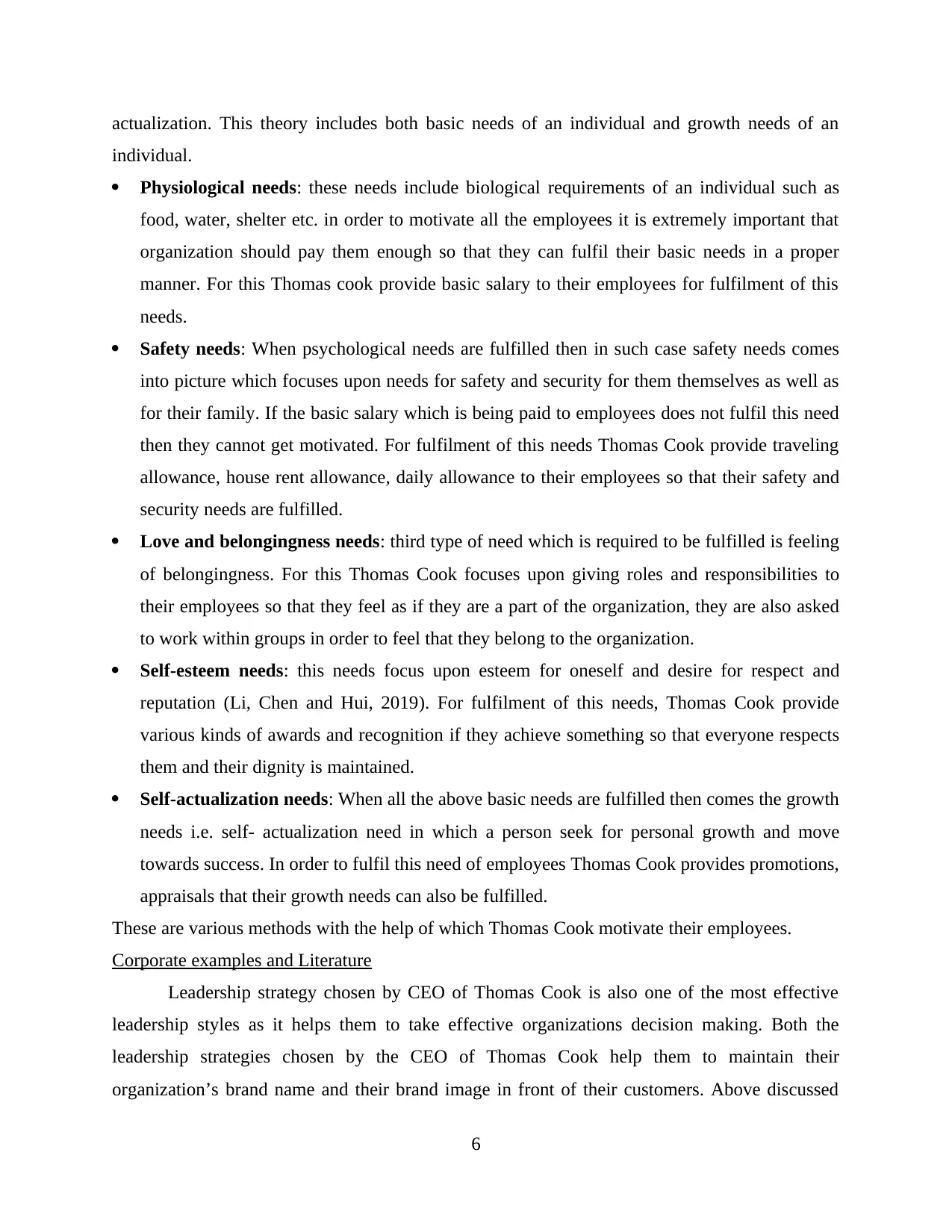
actualization. This theory includes both basic needs of an individual and growth needs of an
individual.
Physiological needs: these needs include biological requirements of an individual such as
food, water, shelter etc. in order to motivate all the employees it is extremely important that
organization should pay them enough so that they can fulfil their basic needs in a proper
manner. For this Thomas cook provide basic salary to their employees for fulfilment of this
needs.
Safety needs: When psychological needs are fulfilled then in such case safety needs comes
into picture which focuses upon needs for safety and security for them themselves as well as
for their family. If the basic salary which is being paid to employees does not fulfil this need
then they cannot get motivated. For fulfilment of this needs Thomas Cook provide traveling
allowance, house rent allowance, daily allowance to their employees so that their safety and
security needs are fulfilled.
Love and belongingness needs: third type of need which is required to be fulfilled is feeling
of belongingness. For this Thomas Cook focuses upon giving roles and responsibilities to
their employees so that they feel as if they are a part of the organization, they are also asked
to work within groups in order to feel that they belong to the organization.
Self-esteem needs: this needs focus upon esteem for oneself and desire for respect and
reputation (Li, Chen and Hui, 2019). For fulfilment of this needs, Thomas Cook provide
various kinds of awards and recognition if they achieve something so that everyone respects
them and their dignity is maintained.
Self-actualization needs: When all the above basic needs are fulfilled then comes the growth
needs i.e. self- actualization need in which a person seek for personal growth and move
towards success. In order to fulfil this need of employees Thomas Cook provides promotions,
appraisals that their growth needs can also be fulfilled.
These are various methods with the help of which Thomas Cook motivate their employees.
Corporate examples and Literature
Leadership strategy chosen by CEO of Thomas Cook is also one of the most effective
leadership styles as it helps them to take effective organizations decision making. Both the
leadership strategies chosen by the CEO of Thomas Cook help them to maintain their
organization’s brand name and their brand image in front of their customers. Above discussed
6
individual.
Physiological needs: these needs include biological requirements of an individual such as
food, water, shelter etc. in order to motivate all the employees it is extremely important that
organization should pay them enough so that they can fulfil their basic needs in a proper
manner. For this Thomas cook provide basic salary to their employees for fulfilment of this
needs.
Safety needs: When psychological needs are fulfilled then in such case safety needs comes
into picture which focuses upon needs for safety and security for them themselves as well as
for their family. If the basic salary which is being paid to employees does not fulfil this need
then they cannot get motivated. For fulfilment of this needs Thomas Cook provide traveling
allowance, house rent allowance, daily allowance to their employees so that their safety and
security needs are fulfilled.
Love and belongingness needs: third type of need which is required to be fulfilled is feeling
of belongingness. For this Thomas Cook focuses upon giving roles and responsibilities to
their employees so that they feel as if they are a part of the organization, they are also asked
to work within groups in order to feel that they belong to the organization.
Self-esteem needs: this needs focus upon esteem for oneself and desire for respect and
reputation (Li, Chen and Hui, 2019). For fulfilment of this needs, Thomas Cook provide
various kinds of awards and recognition if they achieve something so that everyone respects
them and their dignity is maintained.
Self-actualization needs: When all the above basic needs are fulfilled then comes the growth
needs i.e. self- actualization need in which a person seek for personal growth and move
towards success. In order to fulfil this need of employees Thomas Cook provides promotions,
appraisals that their growth needs can also be fulfilled.
These are various methods with the help of which Thomas Cook motivate their employees.
Corporate examples and Literature
Leadership strategy chosen by CEO of Thomas Cook is also one of the most effective
leadership styles as it helps them to take effective organizations decision making. Both the
leadership strategies chosen by the CEO of Thomas Cook help them to maintain their
organization’s brand name and their brand image in front of their customers. Above discussed
6
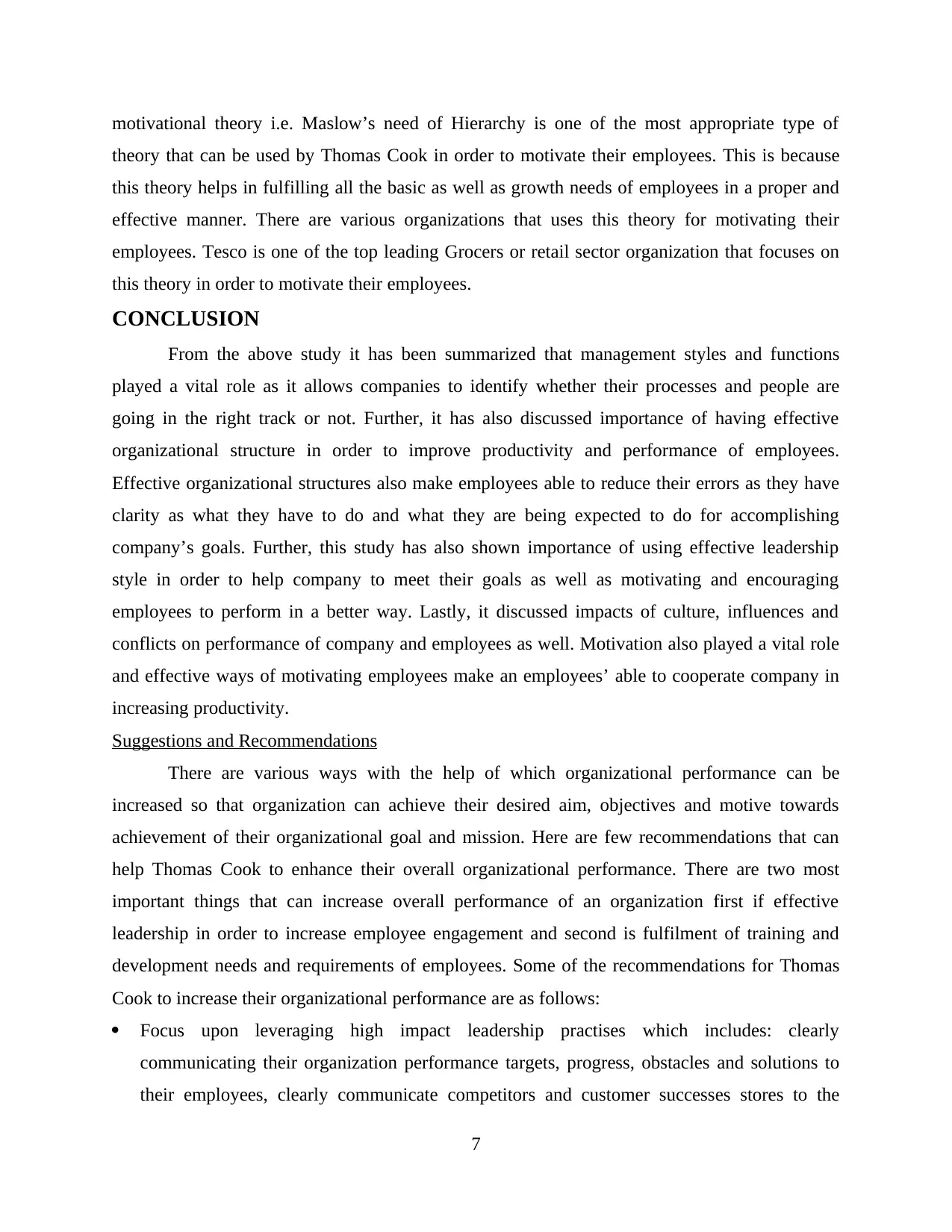
motivational theory i.e. Maslow’s need of Hierarchy is one of the most appropriate type of
theory that can be used by Thomas Cook in order to motivate their employees. This is because
this theory helps in fulfilling all the basic as well as growth needs of employees in a proper and
effective manner. There are various organizations that uses this theory for motivating their
employees. Tesco is one of the top leading Grocers or retail sector organization that focuses on
this theory in order to motivate their employees.
CONCLUSION
From the above study it has been summarized that management styles and functions
played a vital role as it allows companies to identify whether their processes and people are
going in the right track or not. Further, it has also discussed importance of having effective
organizational structure in order to improve productivity and performance of employees.
Effective organizational structures also make employees able to reduce their errors as they have
clarity as what they have to do and what they are being expected to do for accomplishing
company’s goals. Further, this study has also shown importance of using effective leadership
style in order to help company to meet their goals as well as motivating and encouraging
employees to perform in a better way. Lastly, it discussed impacts of culture, influences and
conflicts on performance of company and employees as well. Motivation also played a vital role
and effective ways of motivating employees make an employees’ able to cooperate company in
increasing productivity.
Suggestions and Recommendations
There are various ways with the help of which organizational performance can be
increased so that organization can achieve their desired aim, objectives and motive towards
achievement of their organizational goal and mission. Here are few recommendations that can
help Thomas Cook to enhance their overall organizational performance. There are two most
important things that can increase overall performance of an organization first if effective
leadership in order to increase employee engagement and second is fulfilment of training and
development needs and requirements of employees. Some of the recommendations for Thomas
Cook to increase their organizational performance are as follows:
Focus upon leveraging high impact leadership practises which includes: clearly
communicating their organization performance targets, progress, obstacles and solutions to
their employees, clearly communicate competitors and customer successes stores to the
7
theory that can be used by Thomas Cook in order to motivate their employees. This is because
this theory helps in fulfilling all the basic as well as growth needs of employees in a proper and
effective manner. There are various organizations that uses this theory for motivating their
employees. Tesco is one of the top leading Grocers or retail sector organization that focuses on
this theory in order to motivate their employees.
CONCLUSION
From the above study it has been summarized that management styles and functions
played a vital role as it allows companies to identify whether their processes and people are
going in the right track or not. Further, it has also discussed importance of having effective
organizational structure in order to improve productivity and performance of employees.
Effective organizational structures also make employees able to reduce their errors as they have
clarity as what they have to do and what they are being expected to do for accomplishing
company’s goals. Further, this study has also shown importance of using effective leadership
style in order to help company to meet their goals as well as motivating and encouraging
employees to perform in a better way. Lastly, it discussed impacts of culture, influences and
conflicts on performance of company and employees as well. Motivation also played a vital role
and effective ways of motivating employees make an employees’ able to cooperate company in
increasing productivity.
Suggestions and Recommendations
There are various ways with the help of which organizational performance can be
increased so that organization can achieve their desired aim, objectives and motive towards
achievement of their organizational goal and mission. Here are few recommendations that can
help Thomas Cook to enhance their overall organizational performance. There are two most
important things that can increase overall performance of an organization first if effective
leadership in order to increase employee engagement and second is fulfilment of training and
development needs and requirements of employees. Some of the recommendations for Thomas
Cook to increase their organizational performance are as follows:
Focus upon leveraging high impact leadership practises which includes: clearly
communicating their organization performance targets, progress, obstacles and solutions to
their employees, clearly communicate competitors and customer successes stores to the
7
⊘ This is a preview!⊘
Do you want full access?
Subscribe today to unlock all pages.

Trusted by 1+ million students worldwide
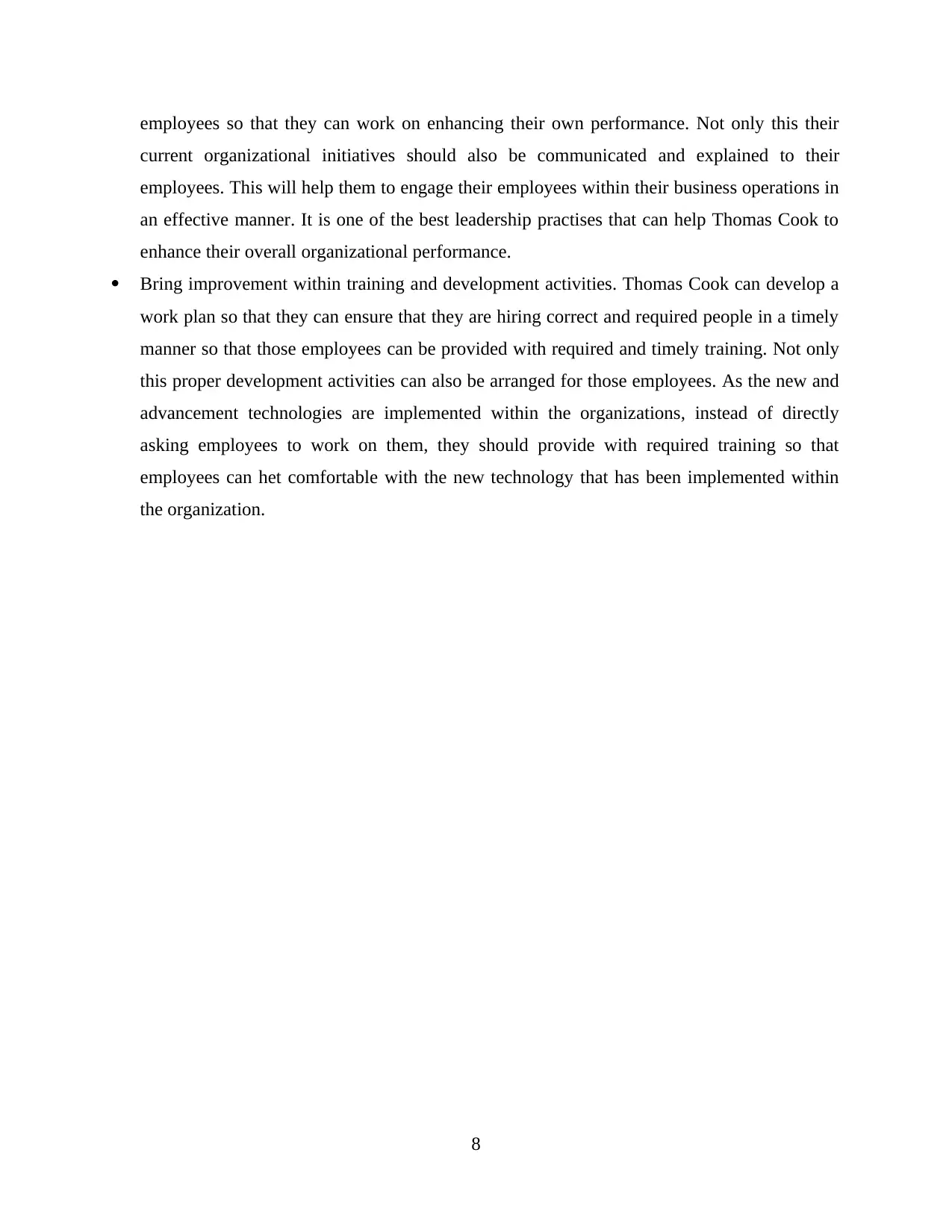
employees so that they can work on enhancing their own performance. Not only this their
current organizational initiatives should also be communicated and explained to their
employees. This will help them to engage their employees within their business operations in
an effective manner. It is one of the best leadership practises that can help Thomas Cook to
enhance their overall organizational performance.
Bring improvement within training and development activities. Thomas Cook can develop a
work plan so that they can ensure that they are hiring correct and required people in a timely
manner so that those employees can be provided with required and timely training. Not only
this proper development activities can also be arranged for those employees. As the new and
advancement technologies are implemented within the organizations, instead of directly
asking employees to work on them, they should provide with required training so that
employees can het comfortable with the new technology that has been implemented within
the organization.
8
current organizational initiatives should also be communicated and explained to their
employees. This will help them to engage their employees within their business operations in
an effective manner. It is one of the best leadership practises that can help Thomas Cook to
enhance their overall organizational performance.
Bring improvement within training and development activities. Thomas Cook can develop a
work plan so that they can ensure that they are hiring correct and required people in a timely
manner so that those employees can be provided with required and timely training. Not only
this proper development activities can also be arranged for those employees. As the new and
advancement technologies are implemented within the organizations, instead of directly
asking employees to work on them, they should provide with required training so that
employees can het comfortable with the new technology that has been implemented within
the organization.
8
Paraphrase This Document
Need a fresh take? Get an instant paraphrase of this document with our AI Paraphraser
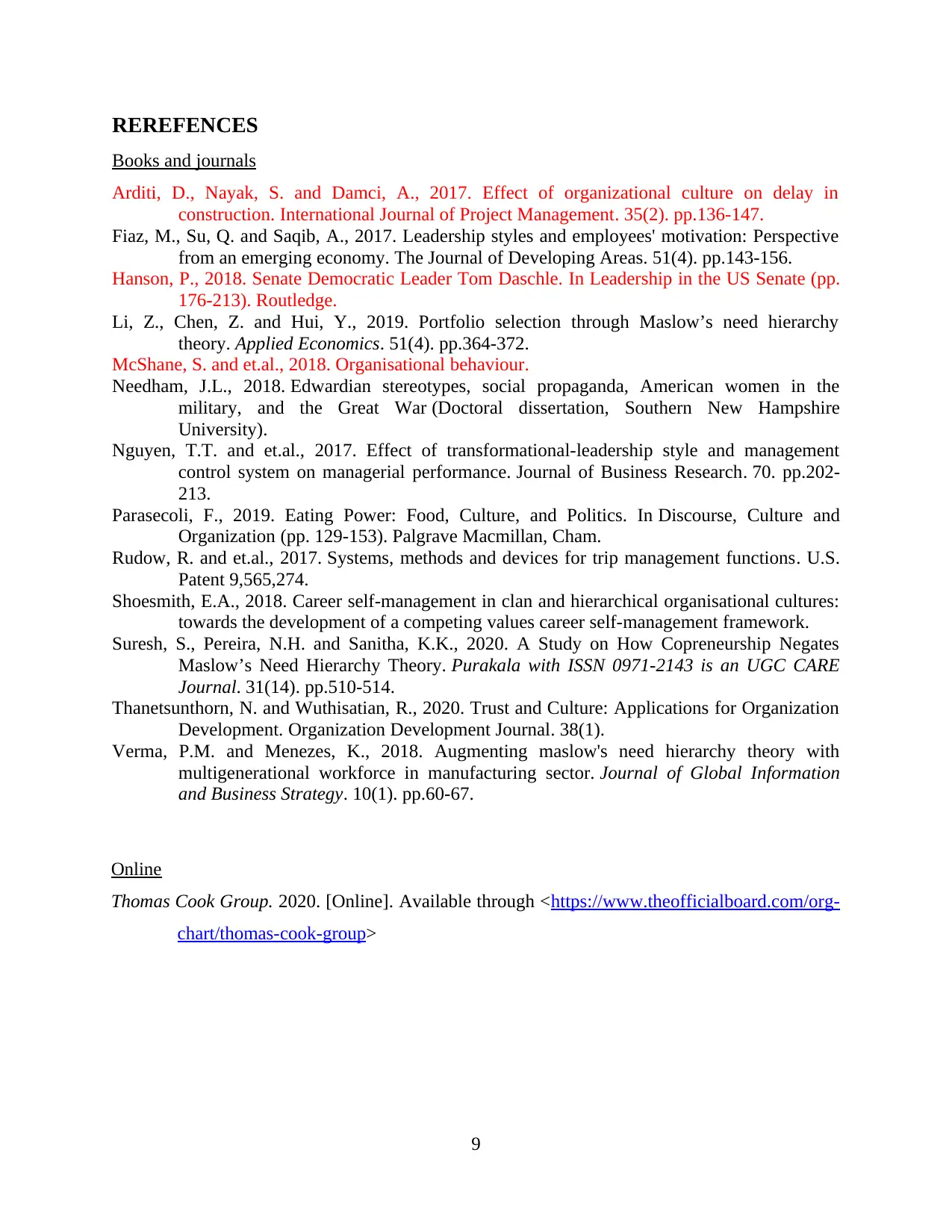
REREFENCES
Books and journals
Arditi, D., Nayak, S. and Damci, A., 2017. Effect of organizational culture on delay in
construction. International Journal of Project Management. 35(2). pp.136-147.
Fiaz, M., Su, Q. and Saqib, A., 2017. Leadership styles and employees' motivation: Perspective
from an emerging economy. The Journal of Developing Areas. 51(4). pp.143-156.
Hanson, P., 2018. Senate Democratic Leader Tom Daschle. In Leadership in the US Senate (pp.
176-213). Routledge.
Li, Z., Chen, Z. and Hui, Y., 2019. Portfolio selection through Maslow’s need hierarchy
theory. Applied Economics. 51(4). pp.364-372.
McShane, S. and et.al., 2018. Organisational behaviour.
Needham, J.L., 2018. Edwardian stereotypes, social propaganda, American women in the
military, and the Great War (Doctoral dissertation, Southern New Hampshire
University).
Nguyen, T.T. and et.al., 2017. Effect of transformational-leadership style and management
control system on managerial performance. Journal of Business Research. 70. pp.202-
213.
Parasecoli, F., 2019. Eating Power: Food, Culture, and Politics. In Discourse, Culture and
Organization (pp. 129-153). Palgrave Macmillan, Cham.
Rudow, R. and et.al., 2017. Systems, methods and devices for trip management functions. U.S.
Patent 9,565,274.
Shoesmith, E.A., 2018. Career self-management in clan and hierarchical organisational cultures:
towards the development of a competing values career self-management framework.
Suresh, S., Pereira, N.H. and Sanitha, K.K., 2020. A Study on How Copreneurship Negates
Maslow’s Need Hierarchy Theory. Purakala with ISSN 0971-2143 is an UGC CARE
Journal. 31(14). pp.510-514.
Thanetsunthorn, N. and Wuthisatian, R., 2020. Trust and Culture: Applications for Organization
Development. Organization Development Journal. 38(1).
Verma, P.M. and Menezes, K., 2018. Augmenting maslow's need hierarchy theory with
multigenerational workforce in manufacturing sector. Journal of Global Information
and Business Strategy. 10(1). pp.60-67.
Online
Thomas Cook Group. 2020. [Online]. Available through <https://www.theofficialboard.com/org-
chart/thomas-cook-group>
9
Books and journals
Arditi, D., Nayak, S. and Damci, A., 2017. Effect of organizational culture on delay in
construction. International Journal of Project Management. 35(2). pp.136-147.
Fiaz, M., Su, Q. and Saqib, A., 2017. Leadership styles and employees' motivation: Perspective
from an emerging economy. The Journal of Developing Areas. 51(4). pp.143-156.
Hanson, P., 2018. Senate Democratic Leader Tom Daschle. In Leadership in the US Senate (pp.
176-213). Routledge.
Li, Z., Chen, Z. and Hui, Y., 2019. Portfolio selection through Maslow’s need hierarchy
theory. Applied Economics. 51(4). pp.364-372.
McShane, S. and et.al., 2018. Organisational behaviour.
Needham, J.L., 2018. Edwardian stereotypes, social propaganda, American women in the
military, and the Great War (Doctoral dissertation, Southern New Hampshire
University).
Nguyen, T.T. and et.al., 2017. Effect of transformational-leadership style and management
control system on managerial performance. Journal of Business Research. 70. pp.202-
213.
Parasecoli, F., 2019. Eating Power: Food, Culture, and Politics. In Discourse, Culture and
Organization (pp. 129-153). Palgrave Macmillan, Cham.
Rudow, R. and et.al., 2017. Systems, methods and devices for trip management functions. U.S.
Patent 9,565,274.
Shoesmith, E.A., 2018. Career self-management in clan and hierarchical organisational cultures:
towards the development of a competing values career self-management framework.
Suresh, S., Pereira, N.H. and Sanitha, K.K., 2020. A Study on How Copreneurship Negates
Maslow’s Need Hierarchy Theory. Purakala with ISSN 0971-2143 is an UGC CARE
Journal. 31(14). pp.510-514.
Thanetsunthorn, N. and Wuthisatian, R., 2020. Trust and Culture: Applications for Organization
Development. Organization Development Journal. 38(1).
Verma, P.M. and Menezes, K., 2018. Augmenting maslow's need hierarchy theory with
multigenerational workforce in manufacturing sector. Journal of Global Information
and Business Strategy. 10(1). pp.60-67.
Online
Thomas Cook Group. 2020. [Online]. Available through <https://www.theofficialboard.com/org-
chart/thomas-cook-group>
9
1 out of 11
Related Documents
Your All-in-One AI-Powered Toolkit for Academic Success.
+13062052269
info@desklib.com
Available 24*7 on WhatsApp / Email
![[object Object]](/_next/static/media/star-bottom.7253800d.svg)
Unlock your academic potential
Copyright © 2020–2025 A2Z Services. All Rights Reserved. Developed and managed by ZUCOL.




